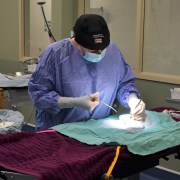May is National Chip Your Pet Month, a reminder for all of us to ensure our pets are microchipped and that their microchip information is updated. Microchipping is an important safeguard to increase the likelihood your pet is returned to you In case they get lost. Our team of experts has compiled the following information to assist you in learning more about the benefits of microchipping and the process of getting your pet microchipped:
HOW MICROCHIPS WORK:
Microchips are small implants that are placed just under your pets’ skin, typically between the shoulder blades. These implants can be scanned for important contact information that can help veterinary clinics or animal shelters like Larimer Humane Society get in touch with you if your pets are lost. Microchip registration numbers can be traced through the Universal Microchip Lookup database regardless the brand of microchip your pet has.
BENEFITS OF MICROCHIPS:
Microchips offer another way for other people to contact you if they find your lost pets. Although your pets should always wear collars with ID tags, license tags and rabies tags, collars can fall off or break, this is where microchips provide an extra layer of protection. Microchips can be scanned by shelters, veterinary clinics, and even animal control officers in the field – helping to ensure your pet is reunited with you as quickly as possible. Microchipping is generally not a painful process for pets, and there’s only a very small risk of any adverse reactions or side effects.
WHERE TO GET MICROCHIPS:
When you adopt a cat or dog from Larimer Humane Society, your adoption includes a microchip implant and registration. For other pets, who are not microchipped, we would be happy to help you with this service, or you can ask your veterinarian to do so. The cost of microchipping is typically $50 or less. You’ll have to make sure that your pets are registered with the microchip company, and it’s important that you keep your pet’s microchip information up to date, should your address or contact information change.








